Goldwork is done – yeah! Time to relax and let it all sink in.
Stitching the RSN Goldwork on silk is challenging but fun, and the best thing was that of all the Certificate classes this was the most relaxed. Maybe I have just become accustomed to the pace of stitching needed in an intensive class?
With the fabulous Shelly Cox as our Tutor, and Nikki as her efficient assistant, and 6 willing students, they made the class a joy. We were organised and assisted, we were given homework sheets to follow, we were told what we had done well and also what needed to be redone, and we all managed to finish our piece on time.
Thinking back over this last two weeks, the thing I have enjoyed the most with Goldwork is learning the order in which to work all of the gold techniques and threads. Padding sets the foundation and getting this right is critical to the success of the final piece. Couching takes concentration and plunging the ends of couched threads is noisy and scary – so easy to get it wrong. Tying back the plunged ends is tedious but necessary. Solid Chipping is a puzzle to solve – can I fit another chip into that space. Cutwork is challenging and needs lots of practice to do well. However I think the end result is worth the effort. Here are a few images of these steps as I did them on my Goldwork piece.
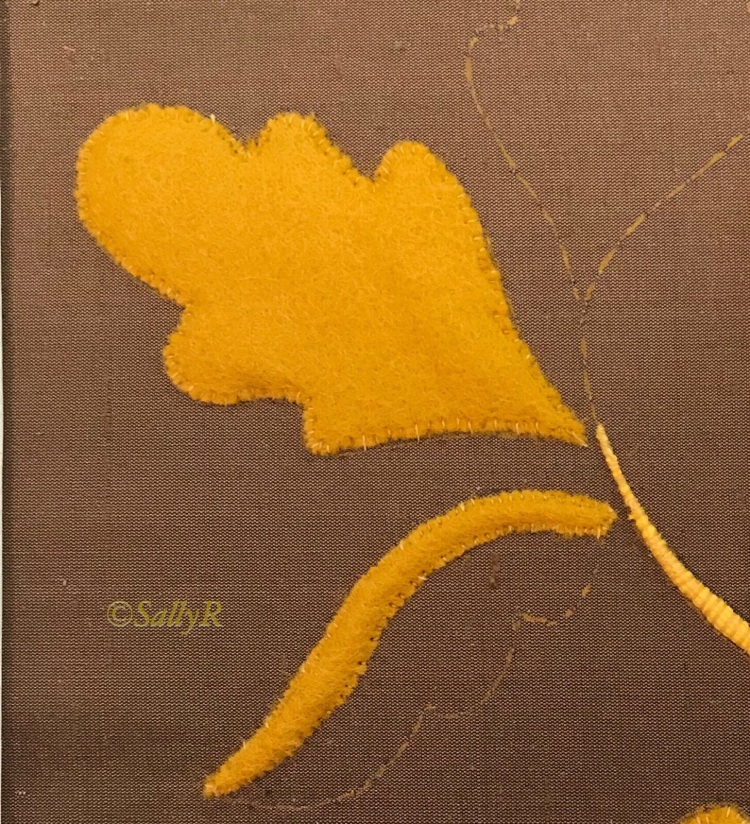
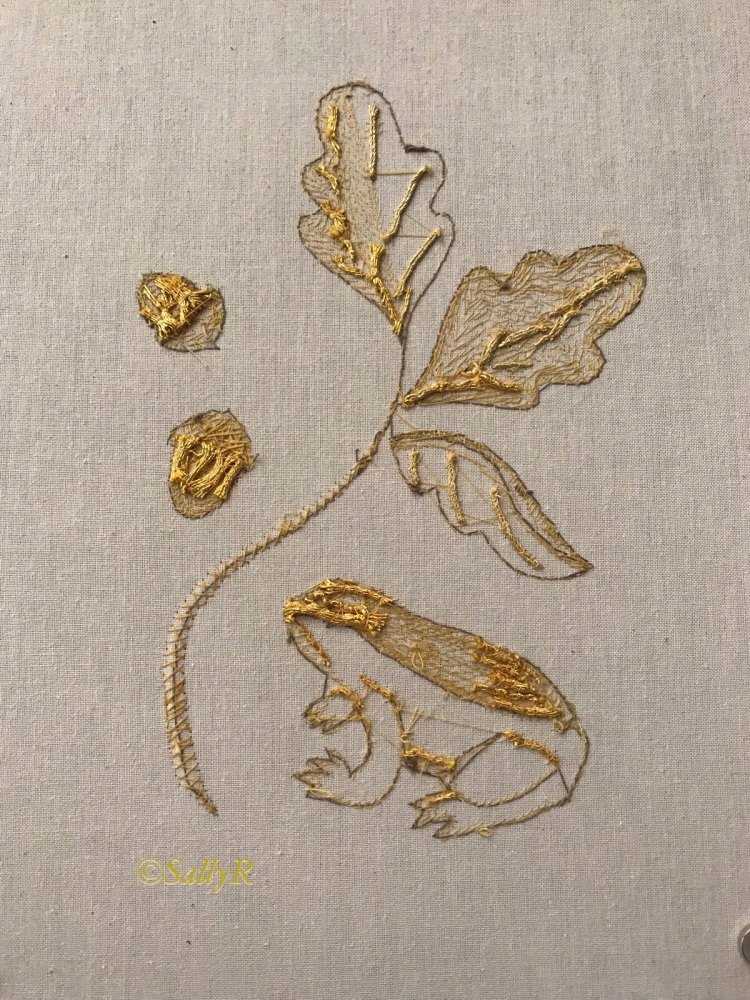
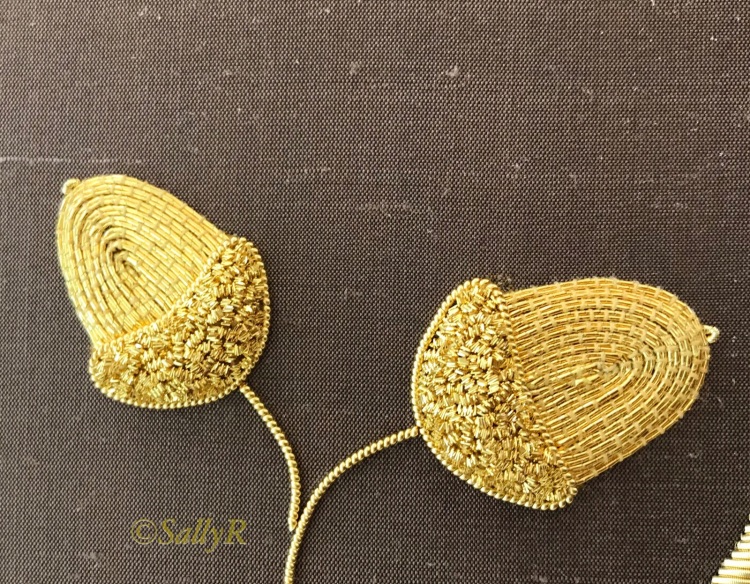
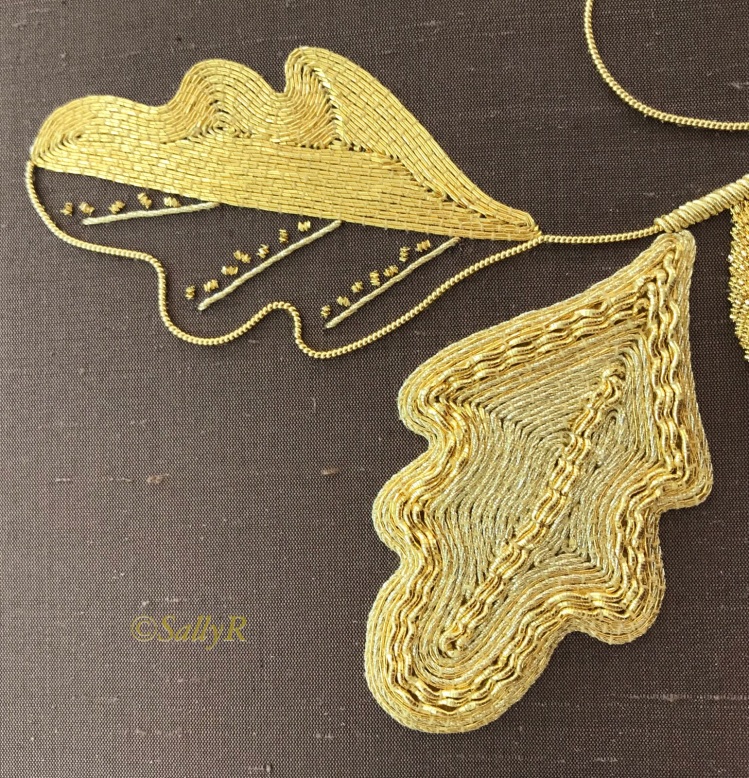
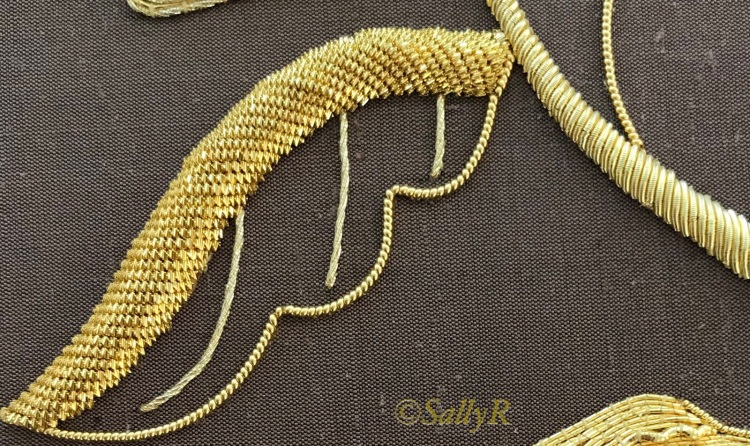
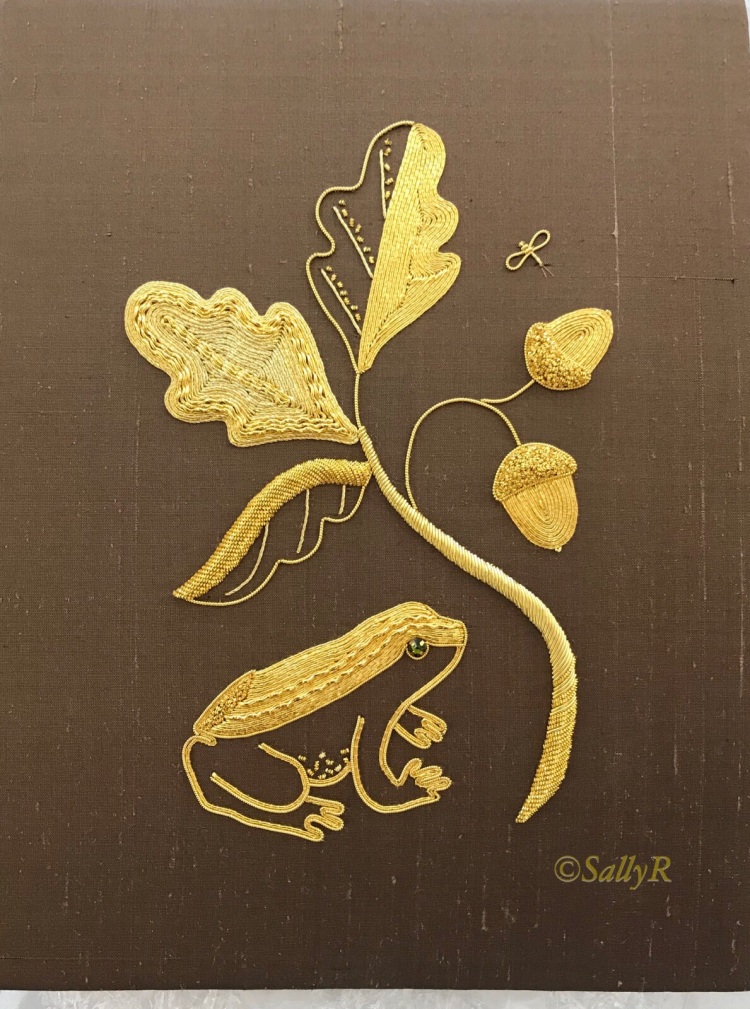
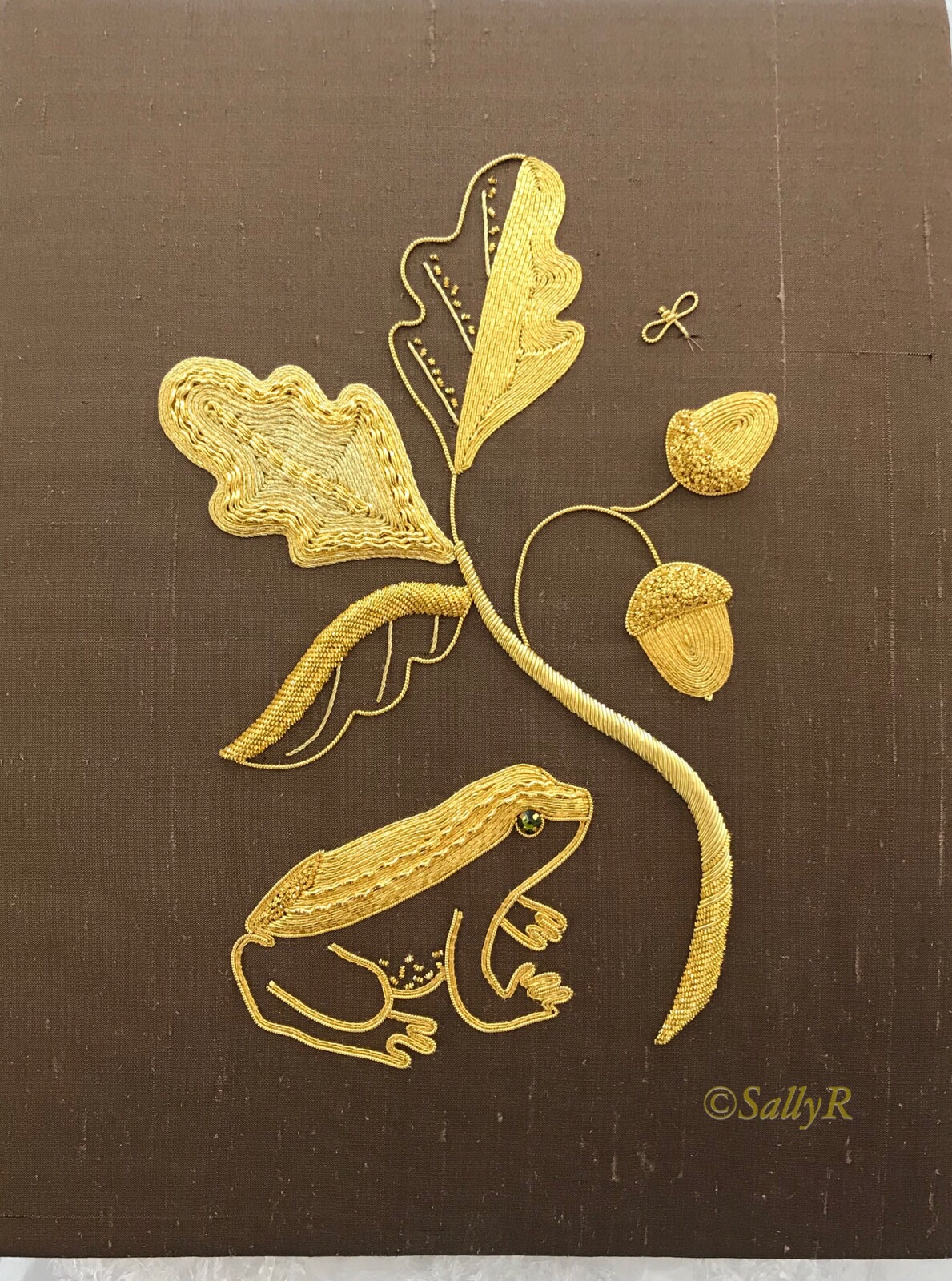
Thank you for showing the step-by-step pictures. Your work is exquisite and so inspirational!
LikeLike
Bravo! Stunning result!! Very well executed! So happy for you!
Enjoy your time off!
LikeLike
What a fantastic job, I love the frog – he is so full of character. And well done to you for finishing all 4 modules! After reading about your journey I think that I will take the silk shading intensive course next year as this seems the most sensible way of completing this module.
LikeLike
Yes I would recommend Silk Shading to be done as an intensive is a great way to get your eye in. I found it took me a little while to really get to understand the colour variations in my image. I think that they are going to make the course one day longer next year by adding in another stitch on own day (no cost) so this should make silkshading achievable. Tips: Don’t go too big and find a nice crisp image. Jump in as soon as bookings are open- these courses are getting really popular.
LikeLiked by 1 person
Thanks, will do!
LikeLike
Utterly stunning! The pattern and texture of the frog’s back is particularly fabulous. :o)
LikeLiked by 1 person
Thank you. He was fun to do and he really came alive when his Jewel eye went in.
LikeLike
Well done Sally! What a great achievement to have finished your Certificate in such a short space of time. You deserve a well earned break. Your frog is just gorgeous. That is a lot of cutwork too! My, I would have gone mad. I’m glad you enjoyed it, it sounds like goldwork might really be your thing. It’s interesting you got extra homework sheets to help. I wonder if they would consider that for term students as well, as I’m sure they would be just as useful(arguably more) useful for them too. Thanks for sharing your journey with us!
LikeLiked by 1 person
Congratulations Sally. I am completely in awe of your stitching and what you have achieved in the short time you had for the course. I just LOVE your frog! Now, enjoy some time off and travelling for a bit.
LikeLiked by 1 person
Thank you for the insight into the intensive classes. I am considering going on this same journey next year. I was wondering whether you had any homework days in between the class days?
LikeLike
Hi Frieda, there is a lot of homework to do in your own time throughout these Intensive modules. Basically you pay for 8 days of tuition and these 8 days are scheduled in across a 12 day block however you are expected to stitch every day. All students work the same days. The pattern for each module is pretty much the same – you start on a Monday doing approximately 3 days of tuition with homework each night, and then you have a full day of stitching on you own (your tutor will tell you what you should get completed), then it is back to the RSN for another couple of days of tuition (with homework each day) and then another stitch on own day, then another couple of tuition days and a stitch on own day till the final day of paid tuition which is usually the day you will take your finished piece off the frame and mount it the RSN way. If you do plan undertake the Intensive then you should expect to have homework every day and also have about 4 full days of stitching on your own (though for these days you can sometimes use the facilities at the RSN if you are staying close to Hampton Court) just to get the piece finished. Please let me know if you have any other questions. Regards, Sally.
LikeLike
Thank you so much for that information Sally, that was very helpful. May I ask where you stayed for such a long period of time? I will be travelling from Australia and have never been to U.K before.
LikeLiked by 1 person
Hi Frideh, staying close to the Palace is really handy as you will not have to be bothered with public transport ( there have been several train strikes since we have been here) however the closer you are the more expensive it is, so I guess it is a trade off. East Molesey is the village nearest the palace, and it has a range of places to stay. The closest hotel is The Mitre, however it is expensive. A couple of my friends stayed in the Lion Gate mews apartments, which is outside one of the side gates of the palace, and they have kitchens and good sized lounge rooms for setting up a stitching place. Really handy for walking to class but a little further from the shops. Depending how long you are staying you want to think about being able to cook and have access to a washing machine. Lots to think about !
LikeLike
Thanks for the information Sally. I would like to ask you about the homework days when you cannot go to the palace to stitch. I am assuming you are working on a slate frame? How do you set that up where you are staying without the base? Many thanks for your help. Frideh
LikeLike
Hi Frideh, sorry it has taken me a little while to get back to you, WIFi has been patchy while traveling. Most of the students improvise some sort of set up for stitching in their rooms. The edge of a table can be used to hold up the frame, or the ironing board can be lowered to rest your frame on. I use the ironing board and have a couple of small clamps to hold mine down. Others have used the backs of two chairs as trestles, while sitting on a third chair. Somehow we have all managed to make do.
LikeLiked by 1 person